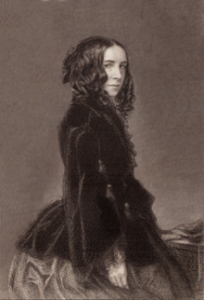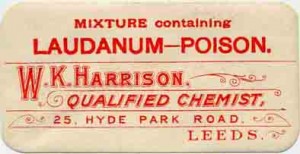By Stephanie Cowell (Former Regular Contributor)
 Elizabeth Barrett began to take laudanum, a tincture of opium, for what is thought to have been a spinal injury at the age of fifteen. It is believed she continued to take it through two more serious illnesses in her early 30s (hemorrhaging of the lungs and some extended unspecified illness). It was almost impossible for her to stop it once she had begun it and it worked for and against her.
Elizabeth Barrett began to take laudanum, a tincture of opium, for what is thought to have been a spinal injury at the age of fifteen. It is believed she continued to take it through two more serious illnesses in her early 30s (hemorrhaging of the lungs and some extended unspecified illness). It was almost impossible for her to stop it once she had begun it and it worked for and against her.
Laudanum is an alcoholic herbal preparation which contains about 10% opium; it is very bitter. It was used for many purposes, principally a pain reliever and cough suppressant. She took it for emotional and physical reasons: to slow her rushing heart and to help her sleep, to suppress the cough which could bring on bleeding. It became for her a general panacea. The drug was also used against menstrual cramps.
Laudanum was entirely uncontrolled in the Victorian era; few people took its side effects seriously. Bouts of euphoria were followed by bouts of depression, slurred speech, restlessness, poor concentration while withdrawal could produce muscular aches and abdominal cramps, agitation, nausea, vomiting and diarrhea. But even infants were spoon fed laudanum and it was not until years after that people realized it was addictive.
An anonymous report, published in The Journal of Mental Sciences January 1889 and called “Confessions of a Young Lady Laudanum-Drinker,” is rather horrifying. The woman wrote, “Laudanum got me into such a state of indifference that I no longer took the least interest in anything, and did nothing all day but loll on the sofa reading novels, falling asleep every now and then, and drinking tea. My married sisters… said I always seemed to be in a half-dazed state, and not to know what I was doing….my memory was getting dreadful.“ After a time, the young woman quit cold, a great difficulty. “My principal feeling was one of awful weariness and numbness at the end of my back; it kept me tossing about all day and night long. It was impossible to lie in one position for more than a minute, and of course sleep was out of the question. Does anyone who has gone up to three or four ounces a day, and is suddenly deprived of it, live to tell the tale! “
 When the poet Robert Browning visited Elizabeth, who was by then much weakened by laudanum and lack of exercise (her family kept her in her room or in the house from fear of what the wretched London fog would do to her lungs), he probably did not understand the extent of the laudanum use. Browning knew she needed to escape from her autocratic father who would not let any of his grown children marry and thus he swept her away to live in Italy. There she regained remarkably good health, though she continued to miscarry her children until Robert and her maid Wilson convinced her to reduce her laudanum dose. Then she bore a healthy child.
When the poet Robert Browning visited Elizabeth, who was by then much weakened by laudanum and lack of exercise (her family kept her in her room or in the house from fear of what the wretched London fog would do to her lungs), he probably did not understand the extent of the laudanum use. Browning knew she needed to escape from her autocratic father who would not let any of his grown children marry and thus he swept her away to live in Italy. There she regained remarkably good health, though she continued to miscarry her children until Robert and her maid Wilson convinced her to reduce her laudanum dose. Then she bore a healthy child.
But for those patients who took laudanum so regularly in the Victorian era, we must consider that there were few other pain relievers until aspirin in 1899. If Mrs. Browning had had antibiotics, she might have cured her lung infection. A mild tranquillizer would have calmed the agitation she felt living with her father (I suspect she had tachycardia). A bit of Ambien or Tylenol PM would have let her sleep. She would not have been so weak.
My research into Elizabeth Barrett Browning is fraught with unanswered questions as must be the research into the health and remedies of most historic people in the Victorian era or earlier. I have read her dosage was at least four times that of the average dosage of opium today. If so, how did she write so much poetry, so many letters? Did it help or harm her? It seems she had pretty good health in the five years after she went to Italy. She could climb steep hills, walk for hours, endure days of jolting carriage rides. When her maid went on holiday, she cared for her toddler. Her health declined around the fifth or sixth year of marriage. Final photographs of her show a very sick woman. Sometimes she could not walk from bed to chair. Did laudanum help her? Or did it hasten her death?
Other laudanum users of the 19th century include Byron, Shelley, Keats, Dickens, Poe, Coleridge, and Sir Arthur Conan Doyle. Elizabeth Eleanor Siddal, the British model, poet, and artist, died of an overdose.
Stephanie Cowell is the author of Nicholas Cooke, The Physician of London, The Players: a novel of the young Shakespeare, Marrying Mozart and Claude & Camille: a novel of Monet. She is the recipient of the American Book Award. Her work has been translated into nine languages. Stephanie is finishing a novel on the love story of Elizabeth Barrett and Robert Browning. Her website is http://www.stephaniecowell.com
This post first appeared on Wonders & Marvels in February 2013.
